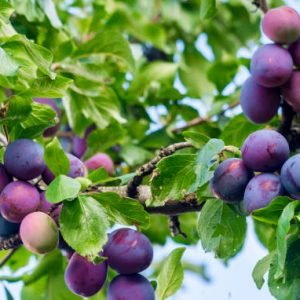Apricot, Prunus armeniaca (Grafted)
Product contains
| Sr No. | Item name |
| 1 | Apricot Plant |
| 2 | Plastic Pot |
Out of stock
₹308.00 ₹600.00
Out of stock
About Apricot, Prunus armeniaca
Apricot trees are small and spreading, with broad ovate leaves that have pointed tips. The leaves are bright green and are held erect on the twigs. The self-pollinated flowers are white in full bloom and borne singly or doubly at a node on very short stems.
The fruits are drupes with a large flat pit, or stone, within which is the seed. The apricot fruit appears similar to a peach or nectarine, with a color ranging from a pale yellow to a deep burnt orange and sometimes a red cast; the flesh ranges from a golden cream color to a brilliant orange Similar in shape to a peach, the fruit is nearly smooth, round to oblong in some varieties, and somewhat flattened but with little to no hairiness when ripe. Its flesh is typically a rich yellow to yellowish orange. The fruit’s surface is smooth and nearly hairless.
Plant specification
| Common Name | Khubani |
| Maximum Reachable Height | 30 feet |
| Flower Colour | White |
| Bloom Time | February |
| Difficulty Level | Easy to moderate |
Apricot, Prunus armeniaca Planting And Care
Sunlight
- Apricot grows well in full sunlight. It requires at least 6-8 hours of direct, unfiltered sunlight every day.
Soil
- This species requires well-drained deep soils with good organic matter.
- Poke your finger/plain small stick into the soil to check the moisture.
- Apply 1 cup (Approx. 50 ml) water when the top soil (3-4 inch) in pot feels dry to touch.
- Apply water probably in the morning or evening time.
- water is required once in a week.
- As a rule of thumb, water the plant thoroughly in the summer and reduce watering in winter and rainy season.
Application of fertilizer
- Before application of fertilizer loosen the topsoil without disturbing the roots of the plant so it can uptake the nutrients and moisture.
- During the main growing season (January-March) feed the plant with organic fertilizer once a month.
- Apply water immediately after application of fertilizer.
Plant Protection
- Remove dead, infected or damaged plant parts and discard them away from the plants.
- For any insect attack or disease, you can use Neem oil, Eucalyptus oil or Citrus oil spray for primary treatment.
Don’ts
- Do not over water the plant especially when pot does not have drainage holes.
- keep away from the AC Vents.
- Do not apply water on plant leaves.
Initial care for 1-2 weeks after receiving plant at your location.
- Check the moisture in the soil before watering it.
- Poke your finger into the soil, if dry then apply water.
- Keep the plant in indirect light.
- Do not repot immediately after receiving it.
Special feature of Apricot, Prunus armeniaca
Apricots are low in fat but rich in vitamin A and beta-carotene. These nutrients act as antioxidants to protect your cells from damage.Rich in vitamin A, beta-carotene, and other carotenoids, apricots are excellent for promoting eye health.
Ornamental uses of Apricot, Prunus armeniaca
Based on 0 reviews
Be the first to review “Apricot, Prunus armeniaca (Grafted)”
You must be logged in to post a review.









There are no reviews yet.